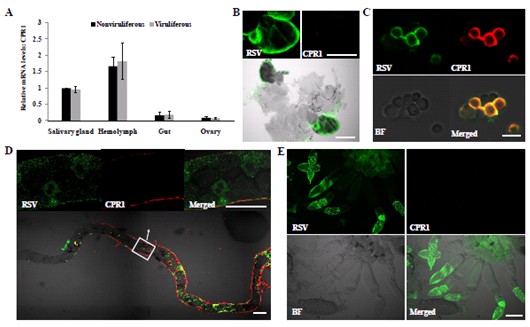MCP:农科院植保所王锡锋研究组发表水稻条纹病毒传播机制
8月1日蛋白组学领域权威期刊《molecular & Cellular Proteomics》在线发表中国农业科学院植物保护研究所作物病毒病害流行与控制创新团队王锡锋研究组最新研究发现,灰飞虱的一种表皮蛋白参与到传播水稻条纹病毒的过程,传毒机制的解析将有助于制定病毒控制的新策略。刘文文博士为第一作者,王锡锋研究员为通讯作者。研究得到了国家973项目和国家自然科学基金的资助。
水稻条纹病毒(RSV)引起的水稻条纹叶枯病是影响水稻生产的重要病害。该病毒由灰飞虱以持久增殖方式传播,病毒可在灰飞虱体内生存,繁殖并能经过昆虫卵传播至后代昆虫体内。一直以来对学术界对病毒如何在灰飞虱体内生存尚不清楚。研究人员基于酵母双杂交膜系统筛选到与病毒核衣壳蛋白互作的大量灰飞虱蛋白为基础,从中选取了一种新的灰飞虱表皮蛋白CPR1进行了传毒功能的深入研究。首先克隆了编码该蛋白的全长基因,并利用免疫共沉淀验证了与RSV核衣壳蛋白存在显著的互作,然后通过酵母双杂交和蛋白质体外结合试验明确了发生互作的结构域。定量检测发现该蛋白在灰飞虱的血淋巴内积累量最高,同时利用激光共聚焦显微镜观察到CPR1与病毒在灰飞虱的血细胞内完全共定位。该研究最后运用RNA干扰技术抑制了CPR1在灰飞虱体内的表达,结果发现该蛋白的表达受到抑制后,灰飞虱血淋巴和唾液腺内的病毒含量也相应显著下降,同时传毒效率也下降到21%。这表明CPR1与RSV的结合可能是帮助病毒逃避了寄主血淋巴的免疫作用从而保护病毒不被降解。

原文链接:
Proteomic Analysis of Interaction between a Plant Virus and Its Vector Insect Reveals New functions of Hemipteran Cuticular Protein
原文摘要:
Numerous viruses can be transmitted by their corresponding vector insects; however, the molecular mechanisms enabling virus transmission by vector insects have been poorly understood, especially the identity of vector components interacting with the virus. Here, we used the yeast two-hybrid system to study proteomic interactions of a plant virus (Rice stripe virus, RSV, genus Tenuivirus) with its vector insect, small brown planthopper (Laodelphax striatellus). Sixty-six proteins of L. striatellus that interacted with the nucleocapsid protein (pc3) of RSV were identified. A virus–insect interaction network, constructed for pc3 and 29 protein homologs of Drosophila melanogaster, suggested that nine proteins might directly interact with pc3. Of the 66 proteins, five (atlasin, a novel cuticular protein, jagunal, NAC domain protein, and vitellogenin) were most likely to be involved in viral movement, replication, and transovarial transmission. This work also provides evidence that the novel cuticular protein, CPR1, from L. striatellus is essential for RSV transmission by its vector insect. CPR1 binds the nucleocapsid protein (pc3) of RSV both in vivo and in vitro and colocalizes with RSV in the hemocytes of L. striatellus. Knockdown of CPR1 transcription using RNA interference resulted in a decrease in the concentration of RSV in the hemolymph, salivary glands and in viral transmission efficiency. These data suggest that CPR1 binds RSV in the insect and stabilizes the viral concentration in the hemolymph, perhaps to protect the virus or to help move the virus to the salivary tissues. Our studies provide direct experimental evidence that viruses can use existing vector proteins to aid their survival in the hemolymph. Identifying these putative vector molecules should lead to a better understanding of the interactions between viruses and vector insects.
doi:10.1074/mcp.M114.046763
作者:王锡锋

